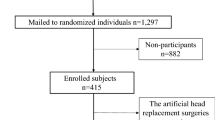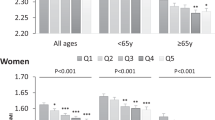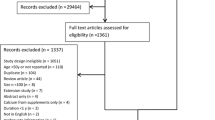Abstract
Objective: Nutrition is an important factor in the prevention and treatment of osteoporosis. Our goal was to examine the relationship between various nutrients and bone mass of several skeletal sites in elderly women, taking into account possible confounding variables.
Design/methods: A cross-sectional study in 136 healthy Caucasian, postmenopausal women, free of medications known to affect bone was carried out. Bone mineral density (BMD) and body composition (lean and fat tissue) were measured by dual X-ray absorptiometry using specialized software for different skeletal sites. Parathyroid hormone (PTH) and vitamin D, 25(OH)D, as possible confounders, were determined in serum samples. Dietary intake, including all supplements, was assessed by 3-day dietary record and analyzed using Food Processor®. Past physical activity and present walking were examined as well and accounted for as potential confounders. Simple and multiple regression models were created to assess the relationships between nutrients and BMD. To examine the co-linear variables and their possible independent association with bone, subgroup analyses were performed.
Results: Showed independent influence of calcium, energy, and protein, examined separately and in multiple regression models on BMD of several skeletal sites. Magnesium, zinc and vitamin C were significantly related to BMD of several skeletal sites in multiple regression models (controlled for age, fat and lean tissue, physical activity and energy intake), each contributing more than 1% of variance. Serum PTH and 25(OH)D did not show significant association with bone mass.
Conclusions: Despite the cross-sectional nature of our study we were able to show a significant relationship between BMD and several critical nutrients: energy, protein, calcium, magnesium, zinc and vitamin C. The exact involvement of these nutrients and their clinical significance in bone health need to be further elucidated in humans and conclusions about the effects of a single nutrient on bone mass must be given cautiously, taking into account its interaction and co-linearity with others. Understanding relationships among nutrients, not just limited to calcium and vitamin D, but others that have not been investigated to such extent, is an important step toward identifying preventive measures for bone loss and prevention of osteoporosis.
This is a preview of subscription content, access via your institution
Access options
Subscribe to this journal
Receive 12 print issues and online access
$259.00 per year
only $21.58 per issue
Buy this article
- Purchase on Springer Link
- Instant access to full article PDF
Prices may be subject to local taxes which are calculated during checkout




Similar content being viewed by others
References
Baron, R (1999). Anatomy and ultrastructure of bone. In:Primer on the Metabolic Bone Disease and Disorders of Mineral Metabolism, ed. MJ Favus, pp3–10, Philadelphia, PA: Lippincott Williams & Wilkins
Beattie, J & Avenell, A (1992). Trace element nutrition and bone metabolism. Nutr. Res. Rev., 5, 167–188.
Black, DM, Cummings, SR, Genant, HK, Nevitt, MC, Palermo, L & Browner, W (1992). Axial and appendicular bone density predict fracture in older women. J. Bone Miner. Res., 6, 633–638.
Blendon, RJ, DesRoches, CM, Benson, JM, Brodie, M & Altman, DE (2001). Americans' views on the use and regulation of dietary supplements. Arch. Intern. Med., 161, 805–810.
Brownbill, RA & Ilich, JZ (2002). Validation of the use of the hand for estimating bone mineral density in other skeletal sites by DXA in healthy and osteoarthritic women. J. Clin. Densitom., 5, 283–293.
Combs, G (1998). The Vitamins, San Diego, CA: Academic Press
Cooper, C, Atkinson, EJ, Hensrud, DD, Wahner, HW, O'Fallon, WM, Riggs, BL & Melton, LJ III (1996). Dietary protein intake and bone mass in women. Calcif. Tissue Int., 58, 320–325.
Coupland, CAC, Cliffe, SJ, Bassey, EJ, Grainge, MJ, Hosking, DJ & Chilvers, CED (1999). Habitual physical activity and bone mineral density in postmenopausal women in England. Int. J. Epidemiol., 28, 241–246.
FASEB (1995). Federation of American Societies for Experimental Biology: Prepared for the Interagency Board for Nutrition Monitoring and Related Research, Washington, DC: US Government Printing Office
Fenton, PH, Collins, MF, Tuxworth, W, Walker, A, Hoinville, E, Cooke, C, Harries, UJ & Rayson, M (1994). Health Education Authority of London Sports Council. The Allied Dunbar National Fitness Survey Technical Report, Sports Council and Health Education Authority, London
Feskanich, D, Willett, WC, Stampfer, MJ & Colditz, GA (1996). Protein consumption and bone fractures in women. Am. J. Epidemiol., 143, 472–479.
Freeman, M, Sargent, R, Sharpe, P, Waller, J, Powell, F & Drane, W (1998). Cognitive, behavioral, and environmental correlates of nutrient supplement use among independently living older adults. J. Nutr. Elderly, 17, 19–40.
Grant, A & DeHoog, S (1999). Nutrient requirements—estimating caloric needs. In:Nutrition Assessment Support and Management, pp308–310, Seattle, WA: Grant, DeHoog
Greendale, GA, Barret-Connor, EL, Edelstein, S, Ingles, S & Haile, R (1995). Lifetime Leisure Exercise and Osteoporosis. Am. J. Epidemiol., 141, 951–959.
Hannan, MT, Tucker, KL, Dawson-Hughes, B, Cupples, LA, Felson, DT & Kiel, DP (2000). Effect of dietary protein on bone loss in elderly men and women: The Framingham Osteoporosis Study. J. Bone Miner. Res., 15, 2504–2512.
Harris, SS & Dawson-Hughes, B (1996). Weight, body composition, and bone density in postmenopausal women. Calcif. Tissue Int., 59, 428–432.
Heaney, RP (1996). Calcium, parathyroid function, bone andaging. [Editorial; comment.]. J. Clin. Endocrinol. Metab., 81, 1697–1698.
Heaney, RP (1997). Nutrient effects: discrepancy between data from controlled trials and observational studies. Bone, 21, 469–471.
Heaney, RP (2000). Calcium, dairy products and osteoporosis. J. Am. Coll. Nutr., 19, 83S–99S.
Ilich, JZ & Kerstetter, EJ (2000). Nutrition in bone health revisited: A story beyond calcium. J. Am. College Nutr., 19, 715–737.
Ilich, JZ, Skugor, M, Hangartner, TBA & Matkovic, V (1998). Relation of nutrition, body composition and physical activity with bone mass: A cross-sectional study in preadolescent females. J. Am. College Nutr., 17, 136–147.
Ilich, JZ, Vollono, JA, Brownbill, RA & Carpenter, TO (1999). Calcium, magnesium and vitamin D intakes in college students: Do they meet new dietary standards?. J. Bone Miner. Res., 14, S518
Ilich, JZ, Zito, M, Brownbill, RA & Joyce, ME (2000). Change in bone mass after Colles' fracture: A case report of unique data collection and long-term implications. J. Clin. Densitom., 3, 383–389.
Ilich, JZ, Brownbill, RA, Ludemann, MA & Fu, R (2002a). Critical factors for bone health in women across the age span: How important is muscle mass?. Medscape Women's Health eJournal, 7, (3) Available at: http://www.medscape.com/viewarticle/432910
Ilich, JZ, Brownbill, RA, Mulrenan, HE & Tamborini, L (2002b). Tracking serum 25 hydroxy vitamin D (25-OHD) and parathyroid hormone (PTH) in healthy elderly women over a 1-year period. Calcif. Tissue. Int., 70, 276
Ilich-Ernst, JZ, McKenna, AA, Badenhop, NE, Clairmont, AC, Andon, MB, Nahhas, RW & Matkovic, V (1998). Iron status, menarche, and calcium supplementation in young females. Am. J. Clin. Nutr., 68, 880–887.
Institute of Medicine (1997). Dietary Reference Intakes for Calcium, Phosphorus, Magnesium, Vitamin D, and Fluoride, Washington, DC: National Academy Press
Institute of Medicine (1998). Dietary Reference Intakes for Thiamin, Riboflavin, Niacin, Vitamin B6, folate, Vitamin B12, Panthotenic acid, Biotin, and Choline, Washington, DC: National Academy Press
Institute of Medicine (2000). Dietary Reference Intakes for Vitamin C, Vitamin E, Selenium, and Carotenoids, Washington, DC: National Academy Press
Institute of Medicine (2001). Dietary Reference Intakes for Vitamin A, Vitamin K, Arsenic, Boron, Chromium, Copper, Iodine, Iron, Manganese, Molybdenum, Nickel, Silicon, Vanadium, and Zinc, Washington, DC: National Academy Press
Jacques, PF, Felson, DT, Tucker, KL, Mahnken, B, Wilson, PWF, Rosenberg, IH & Rush, D (1997). Plasma 25-hydroxyvitamin D and its determinants in an elderly population. Am. J. Clin. Nutr., 66, 929–936.
Kerstetter, JE & Allen, LH (1994). Protein intake and calcium homeostasis. Adv. Nutr. Res., 9, 167–181.
Kerstetter, JE, Caseria, DM, Mitnick, ME, Ellison, AF, Gay, LF, Liskov, TA, Carpenter, TO & Insogna, KL (1997). Increased circulating concentrations of parathyroid hormone in healthy, young women consuming a protein-restricted diet. Am. J. Clin. Nutr., 66, 1188–1196.
Kerstetter, JE, O'Brien, KO & Insogna, KL (1998). Dietary protein affects intestinal calcium absorption. Am. J. Clin. Nutr., 68, 859–865.
Kerstetter, J, Svastisalee, C, Caseria, D, Mitnick, M & Insogna, K (2000a). A threshold for low-protein-diet-induced elevations in parathyroid hormone. Am. J. Clin. Nutr., 72, 168–173.
Kerstetter, JE, Looker, AC & Insogna, KL (2000b). Low protein intake and low bone density. Calcif. Tissue Int., 66, 313
Leveille, SG, LaCroix, AZ, Koepsell, TD, Beresford, SA, Van Belle, G & Buchner, DM (1997). Dietary vitamin C and bone mineral density in postmenopausal women in Washington State, USA. J. Epidemiol. Community Health, 51, 479–485.
Lindsay, R, Cosman, F, Herrington, BS & Himmelstein, S (1992). Bone mass and body composition in normal women. J. Bone. Miner. Res., 1, 55–63.
Medeiros, DM, Ilich, JZ, Ireton, J, Matkovic, V, Shiry, L & Wildman, R (1997). Femurs from rats fed diets deficient in copper or iron have decreased mechanical strength and altered mineral composition. J. Trace Elem. Exp. Med., 10, 197–203.
Melhus, H, Michalsson, K, Holmberg, L, Wolk, A & Ljunghall, S (1999). Smoking, antioxidant vitamins, and the risk of hip fracture. J. Bone Miner. Res., 14, 129–135.
Meyer, HE, Pedersen, JI, Loken, EB & Tverdal, A (1997). Dietary factors and the incidence of hip fracture in middle-aged Norwegians. A prospective study. Am. J. Epidemiol., 145, 117–123.
Morton, DJ, Barret-Connor, EL & Schneider, DL (2001). Vitamin C supplement use and bone mineral density in postmenopausal women. J. Bone Miner. Res., 16, 135–140.
Mundy, GR (1999). Bone remodeling. In:Primer on the Metabolic Bone Disease and Disorders of Mineral Metabolism, ed. MJ Favus, pp30–38, Philadelphia, PA: Lippincott Williams and Wilkins
National Research Council (1989). Recommended Dietary Allowances, Report, 10th edn Washington, DC: National Academy Press
New, SA, Bolton-Smith, C, Grubb, DA & Reid, DM (1997). Nutritional influences on bone density: a cross-sectional study in premenopausal women. Am. J. Clin. Nutr., 65, 1831–1839.
New, SA, Robins, SP, Campbell, MK, Martin, JC, Garton, MJ, Bolton-Smith, C, Grubb, DA, Lee, SJ & Reid, DM (2000). Dietary influences of bone mass and bone metabolism: further evidences of a positive link between fruit and vegetable consumption and bone health?. Am. J. Clin. Nutr., 71, 142–151.
NOF (1998). Osteoporosis: Physician's Guide to Preventing and Treating Osteoporosis, Washington, DC: National Osteoporosis Foundation
Pocock, NA, Eisman, JA, Hopper, JL, Yeates, MG, Sambrook, PN & Eberl, S (1987). Genetic determinants of bone mass in adults. A twin study. J. Clin. Invest., 80, 706–710.
Prockop, DJ (1971). Role of iron in the synthesis of collagen in connective tissue. Fed. Proc., 30, 984–990.
Riggs, BL & Melton, LJ (1986). Medical progress series: Involutional osteoporosis. New Engl. J. Med., 314, 1676–1686.
Rude, RK (1998). Magnesium deficiency: a cause of heterogeneous disease in humans. J. Bone Miner. Res., 13, 749–758.
Svendsen, OL, Hassager, C & Christiansen, C (1993). Effect of an energy-restrictive diet, with or without exercise, on lean tissue mass, resting metabolic rate, cardiovascular risk factors, and bone in overweight postmenopausal women. Am. J. Med., 95, 131–140.
Takada, H, Washino, K & Iwata, H (1997). Risk factors for low bone mineral density among females: the effect of lean body mass. Prev. Med., 26, 633–638.
Thomas, MK, Lloyd-Jones, DM & Thadan, RI (1998). Hypovitaminosis D in medical inpatients. New Engl. J. Med., 338, 777–783.
Tucker, KL, Hannan, MT, Chen, H, Cupples, LA, Wilson, PW & Kiel, DP (1999). Potassium, magnesium, and fruit and vegetable intakes are associated with greater bone mineral density in elderly men and women. Am. J. Clin. Nutr., 69, 727–736.
Velleman, PF (1997). Data Desk—Statistics Guide, Ithaca, NY: Data Description Inc
WHO (1994). Study Group on Assessment of Fracture Risk and its Application to Screening and Postmenopausal Osteoporosis, Publication no. 843 Geneva: World Health Organization
Acknowledgements
This study was funded in part by the NRI/USDA 2001-00836, Donaghue Medical Research Foundation DF98-056, and the University of Connecticut Office for Sponsored Programs. The authors want to express their appreciation and thanks to all the women who participated in the study. Parts of this study were presented in a poster session at the International Bone and Mineral Society, June 2001, in Madrid, Spain.
Author information
Authors and Affiliations
Contributions
Guarantors: JZ Ilich and RA Brownbill.
Contributors: JZI is a principal investigator and was responsible for analyzing the data and writing the manuscript; RAB was responsible for collecting all data and analyzing nutritional and physical activity; LT was responsible for helping with the study and collecting information on nutritional supplements.
Corresponding author
Rights and permissions
About this article
Cite this article
Ilich, J., Brownbill, R. & Tamborini, L. Bone and nutrition in elderly women: protein, energy, and calcium as main determinants of bone mineral density. Eur J Clin Nutr 57, 554–565 (2003). https://doi.org/10.1038/sj.ejcn.1601577
Received:
Revised:
Accepted:
Published:
Issue Date:
DOI: https://doi.org/10.1038/sj.ejcn.1601577
Keywords
This article is cited by
-
Is Zinc an Important Trace Element on Bone-Related Diseases and Complications? A Meta-analysis and Systematic Review from Serum Level, Dietary Intake, and Supplementation Aspects
Biological Trace Element Research (2021)
-
Dietary protein and bone health across the life-course: an updated systematic review and meta-analysis over 40 years
Osteoporosis International (2019)
-
The relationship between protein quantity, BMD and fractures in older adults
Irish Journal of Medical Science (1971 -) (2018)
-
Sequential activation of the AKT pathway in human osteoblasts treated with Oscarvit: a bioactive product with positive effect both on skeletal pain and mineralization in osteoblasts
BMC Musculoskeletal Disorders (2017)
-
Relationship Between Nutritional Factors and Hip Bone Density in Individuals with Chronic Stroke
Calcified Tissue International (2017)



